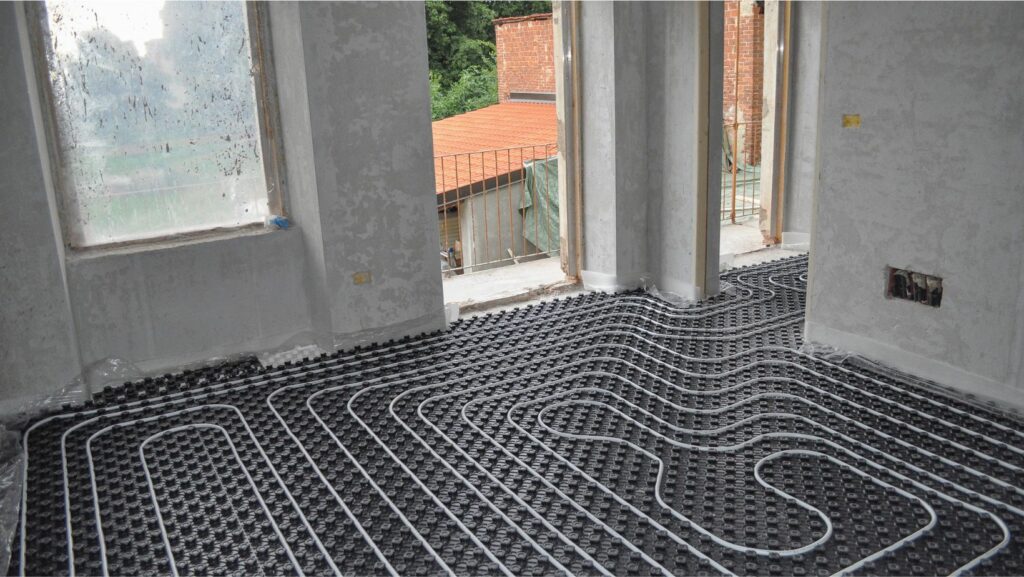
Regarded as a pinnacle of modern innovation, underfloor heating transforms your house into an efficient and comfortable home. It’s a system that brings warmth into your living space, creating a cozy sanctuary for you to relax in after a long day.
History of Underfloor Heating
The origins of underfloor heating can be traced back to ancient civilizations, notably the Romans, who circulated warm air beneath elevated floors to heat their homes and public baths. These systems, known as hypocausts, featured a network of channels where hot air from the furnace passed through, warming the floor above.
Then towards the end of the 20th century, underfloor heating experienced a resurgence. This was primarily due to the advancements of technology and in materials. Electric underfloor heating then emerged as a practical alternative to water-based systems. Offering greater flexibility and efficiency.
Mechanics of Underfloor Heating
Underfloor heating works on the principle of radiant heat transfer. This is where heat radiates from a warm surface to cooler objects and bodies in the room. Unlike conventional forced-air systems that rely on convection, underfloor heating ensures an even distribution of warmth from the ground up. It minimizes heat loss and maximizes comfort.

There are two main types of underfloor heating systems: electric and hydronic (water-based). Electric systems consist of heating cables or mats installed beneath your floor surfaces. Hydronic systems, on the other hand, utilize water heated by a boiler or heat pump, circulating it through a network of pipes laid within your floor.
Compatible Flooring
One of the key factors to consider is the type of flooring material to use. Underfloor heating is compatible with a wide range of materials, but some conduct heat more effectively than others and may influence the overall performance of the system.
Tiles and stone flooring, such as porcelain and ceramic, are excellent conductors of heat and they’re commonly used with underfloor heating systems. These materials retain heat effectively, ensuring efficient warmth distribution throughout your room. However, it is essential to choose a thin-set adhesive and grout suitable for underfloor heating applications to prevent heat loss.

Engineered wood flooring is an ideal choice. Composed of multiple layers of softwood, plywood, and high-density fibreboard with a solid oak veneer on top, engineered wood is more stable and less prone to swelling or shrinking with temperature changes.
Laminate flooring is a cost-effective alternative to wood flooring and is also compatible with underfloor heating. However, it’s essential that you pick laminate products that are specifically designed for underfloor heating to ensure the best performance and durability.
Luxury vinyl tiles are another budget-friendly option. They can mimic natural materials such as wood and stone. They’re a popular choice due to their versatility, durability, and compatibility with underfloor heating; they provide excellent heat conduction, ensuring efficient warmth distribution across your floor.
Benefits of Underfloor Heating
Enhanced Comfort: underfloor heating eliminates cold spots and drafts, providing consistent warmth across your entire floor area.
Energy Efficiency: underfloor heating offers many advantages, and one of the biggest is its ability to maximize energy efficiency in your home.
Running at lower temperatures than traditional radiators, underfloor heating reduces energy consumption and will lower your heating bills. Radiant heat also retains warmth for longer periods.
Space Saving: unlike bulky radiators, underfloor heating is discreetly integrated into your floor structure. This frees up valuable wall and floor space for your furniture and decor.
Health and Safety: with no hot surfaces or exposed elements, underfloor heating is safer for your family. It also minimizes air circulation, reducing the spread of dust, allergens, and airborne pollutants; it promotes better indoor air quality, too.
Environmental Impact
Underfloor heating, especially hydronic systems, can contribute to energy efficiency and environmental sustainability when you pair them with renewable energy sources such as solar thermal or geothermal heat pumps. By reducing your reliance on fossil fuels and minimising heat loss, underfloor heating helps mitigate carbon emissions and combat climate change.












